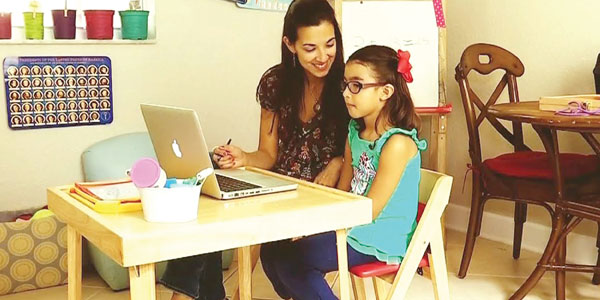
By Jorge Ramos
NO TALKING FACE TO FACE, NO HUGGING OR KISSING CAN BECOME AN UNHEALTHY HABIT FOR THIS GENERATION. THEY WOULD BE MISSING THE SWEETEST THINGS ABOUT BEING HUMAN.
MIAMI — The door of Carlota’s room is ajar, so I peek inside to see what she’s doing. She’s sitting upright at her desk with her laptop in front of her. On the screen are a dozen of her schoolmates, all of them, like Carlota, participating in a virtual class. I can tell that their teacher is leading the lesson from her home — I’m pretty sure they’re discussing fractions and decimals — but Carlota and her friends are following closely along as if she were talking to them in person.
Everything seems normal. And yet nothing is.
I live in the same house as Carlota, a wonderful, loving and brilliant 9-year-old girl, and the daughter of Chiquinquirá Delgado, my partner. Carlota brought happiness into my life from the moment I met her, just a few months after her birth, and I couldn’t imagine this house without her in it. “Good morning everyone!” she shouts from her bedroom when she wakes up. Her tireless energy — she loves to create dance moves — and curiosity has made the tedium of quarantine a bit easier to endure.
Carlota — like the roughly half of the world’s population living in coronavirus-induced lockdown — has been stuck at home for several weeks now, and there are times when her sadness and frustration rise to the surface. Like when she wonders, with tears in her eyes, if we’ll still be able to throw her a birthday party in May. Or when she wants to get together with her friends and doesn’t quite understand why they can’t come over. One of our biggest achievements as parents during the crisis was taking Carlota on a short bike ride with one of her friends. The kids enjoyed it, but saying goodbye without touching was really hard for them.
The truth, however, is that Carlota’s generation — there are an estimated 74 million children under 17 in the United States — is much better prepared than ours to face months of isolation. These young people have been unintentionally training for this moment all their lives. From a very young age, they’ve been communicating with one another using devices that never existed in my time. So when we told them they couldn’t leave the house, all they did was enter “virtual mode.”
Faced with adversity due to an uncooperative virus, Carlota has reproduced her old social world in her bedroom, with all her games, music and friends within easy reach; even her classroom is there. She often has three screens going simultaneously: the TV (where she’s watching a movie or a series), her smartphone (where she’s talking with friends on FaceTime) and her iPad. With all her devices, Carlota has created a digital geography that would be impossible for me to navigate. She’s lucky that the internet is working so well in the Miami area where we live. If we were somewhere else, like Brownsville, Texas, for example, the connection might not be so stable.
For weeks now, Carlota has been building an imaginary digital house using the simulation game Bloxburg, making videos based on Billie Eilish’s music on TikTok (her account is private; only her friends have access) and drawing amazing works of art with the Procreate app. This cyberswarm is the center of Carlota’s new life. For her and her friends, almost everything is temporary and disposable. “That’s so 2019,” she tells me when I ask her about apps and platforms she no longer uses.
The virus, however, is still here.
These days, Carlota has new fears. Her once quiet and predictable nights, which always included 20 minutes of reading, have become chaotic and irregular, almost like a teenager’s. Noises she once ignored now awaken her. Each night, she tries to soothe her anxieties with a different plush toy. She knows each toy’s name by heart and where it came from. The ritual of choosing the “plush of the night” is worthy of a reality show, with jubilant winners and vanquished losers.
As a family, we’ve established fixed mealtimes, with no electronic devices, and we try not to talk about the coronavirus when Carlota is present. But we don’t change the subject if she brings it up, and we try to answer all her questions as best we can. The virus haunts all of us, keeping us awake at night. It’s everywhere — on the door handles we touch, the packages that show up at our door, the phone conversations we have with friends and family, and in the new rules that keep us locked inside.
Carlota is unlikely to return to school to finish the fourth grade. I hear the school year may be extended a couple of weeks into the summer. I hope it will. Regardless, teaching our children effectively during a health crisis like this will require extraordinary endurance and creativity. Everything indicates that, even in the best-case scenario, we won’t have a vaccine until 2021.
The children of the 2020 pandemic have a lot to teach us. They adapt quickly to new situations and use technology with astonishing proficiency: Carlota and her friends can Google a solution to nearly any problem. I want to believe that if they were the ones in charge, they wouldn’t have wasted weeks — like our current leaders did — in confronting the coronavirus. In the future, I hope Carlota’s generation puts the interests of science and health above those of politics and prejudice.
Whether she knows it or not, Carlota is already a survivor, and she’s better prepared than I am to face the crisis ahead. I envy the strength and resilience of both her lungs and her attitude toward life.
I’m pretty sure that Carlota has the numbers of more close friends saved in her phone than I do. But, at least for now, she can’t play with them as I did with mine when I was her age. And I fear that social distancing will become an unhealthy habit for Carlota and her peers. No talking face to face, no hugging or kissing. They’re missing the sweetest things about being human.
I can barely make out half of Carlota’s back through the semi-open door of her room, but she sees me before I can walk away. “¡Te quiero mucho!” I tell her in Spanish. “I love you too!” she responds, with a giant smile. And somehow the two of us, with heavy hearts, resist the urge to hug each other.
_______________________________________________________________________________
El mundo de Carlota: lo que nos enseñan los niños en la pandemia
LOS JÓVENES PARECEN MÁS PREPARADOS PARA ENFRENTAR EL BROTE DEL CORONAVIRUS QUE LOS MAYORES. PODEMOS APRENDER ALGUNAS LECCIONES DE ELLOS.
La puerta del cuarto de Carlota está entreabierta y me asomo a ver qué está haciendo. Está sentada, con la espalda recta, en su escritorio blanco y en la pantalla de su laptop hay una docena de sus compañeros de escuela en una clase virtual. La maestra, desde su casa, está impartiendo la clase —creo que hablan de fracciones y decimales— y Carlota y sus amigos la siguen como si estuviera en persona.
Todo parece normal. Pero nada lo es.
Vivo en la misma casa que Carlota, una maravillosa, cariñosa y brillante niña de nueve años, hija de Chiquinquirá Delgado, mi pareja. Carlota me ha alegrado la vida desde que la conocí, apenas unos meses después de nacida, y no me puedo imaginar la casa sin ella. “Buenos días a todos”, grita desde su cuarto cuando se despierta, y su incansable energía —le encanta inventarse pasos de baile— y curiosidad hace más placenteros estos tediosos días de cuarentena.
Ella —al igual que aproximadamente la mitad de la humanidad está en algún tipo de aislamiento— lleva varias semanas encerrada en casa y hay momentos en que la tristeza y la frustración se notan. Como cuando se pregunta, con lágrimas rodando, si podremos hacer su fiesta de cumpleaños en mayo o cuando quiere reunirse con sus amigas y le cuesta entender por qué no las dejan venir a jugar. Lo más que logramos, el fin de semana pasado, fue un breve paseo en bicicleta con una de sus amigas. Ellas lo gozaron. Pero la despedida, sin tocarse, fue durísima.
Su generación —hay alrededor de 74 millones de menores de 17 años de edad en Estados Unidos— está mucho mejor preparada que la nuestra para enfrentar meses de encierro. Ellos se habían entrenado, sin proponérselo, para el distanciamiento social. Desde pequeños se comunican entre sí con aparatos que nunca existieron en mi infancia. Así que cuando les dijimos que no podían salir de casa, lo único que hicieron fue entrar en modo virtual.
Ante la adversidad por un virus que no coopera, Carlota ha recreado y acomodado su antiguo mundo en su recámara: sus juegos, sus amigos, su música y hasta su salón de clases. Cuando nos descuidamos, tiene tres pantallas prendidas: el televisor (generalmente con una película o una serie), su celular con una o dos amigas en FaceTime y su iPad, donde ha creado una nueva geografía digital que yo no podría navegar. Tiene suerte que el internet funciona bien en la zona de Miami donde vivimos. Si estuviéramos en Brownsville, en Texas, por ejemplo, la conexión sería mucho más difícil.
Carlota lleva semanas construyendo una casa imaginaria en Bloxburg (un juego de la plataforma de Roblox), haciendo videos con la música de Billie Eilish en la aplicación de TikTok —su cuenta es privada y sólo sus amigas tienen acceso— y dibujando alucinantes obras de arte en Procreate. Ese enjambre cibernético es el centro de su nueva vida. Pero para ella y sus amigas casi todo es temporal y desechable. “That’ so 2019”, me dice, cuando le pregunto de aplicaciones y plataformas que ya no usa.
El virus, sin embargo, sigue ahí.
Carlota tiene nuevos miedos. Sus tranquilas y predecibles noches, que incluían siempre 20 minutos de lectura, han dado paso a horarios casi de adolescente. Ruidos que antes pasaban desapercibidos ahora la despiertan. Ella enfrenta sus recientes temores con un muñeco de peluche distinto cada noche. Se sabe de memoria los nombres de cada uno y el lugar donde lo adquirió. El ritual para elegirlo es digno de un programa de reality, con ganadores y perdedores.
Como familia nos hemos impuesto horas fijas de comida, sin aparatos electrónicos, y tratamos de no hablar de enfermedades cuando está presente. Pero contestamos sus preguntas y no evitamos el tema. El virus nos persigue —en las manijas de las puertas, en los paquetes que no dejan de llegar, en las conversaciones telefónicas, en las nuevas reglas— y nos quita el sueño a todos.
Es poco probable que Carlota regrese a la escuela para terminar el cuarto grado. Oigo que le quieren robar un par de semanas académicas al verano. Ojalá. Pero habrá que ser muy creativos para educar a los niños durante el coronavirus porque todo indica que no tendremos vacuna hasta 2021, si nos va bien.
Es casi seguro que la lista de amigos favoritos en el celular de Carlota es más grande que la mía. Pero ahora no puede acercarse y jugar con sus compañeros como yo hice con los míos cuando tenía su edad.
Ahora lo normal ha sido reemplazado por la tragedia. Acabo de recibir una foto del hospital que construyeron dos niñas con almohadas y muñecas.
Los niños de la pandemia de 2020 tienen mucho que enseñarnos. Se adaptan rápido ante nuevas circunstancias e inmediatamente googlean una solución a sus problemas. Es probablemente la primera generación que maneja la tecnología mejor que la que le precedió. Y quiero creer que si ellos nos gobernaran no habrían perdido semanas, como nosotros, para enfrentar al coronavirus. Espero que ellos pongan la ciencia y la salud por encima de los prejuicios y los intereses políticos.
Carlota, sin saberlo, ya es una sobreviviente y está mejor preparada que yo para enfrentar esta crisis. Envidio sus pulmones y su actitud ante la vida, ambos resistentes y flexibles. Pero temo que este distanciamiento se convierta para ella y el resto de los niños y jóvenes en una costumbre. Sin abrazos y compartir cara a cara, sin tocarse, sin besarse. Se están perdiendo lo más rico de ser humanos.
Veo apenas la mitad de su espalda, a través de la puerta de su cuarto, y me descubre antes que pueda alejarme. “Te quiero mucho”, le digo. “I love you too”, me contesta en inglés con una sonrisa gigante. Y los dos, con el corazón apretujado, nos aguantamos el abrazo.









